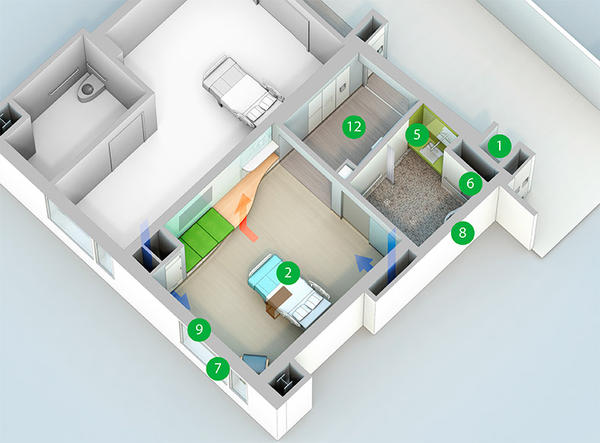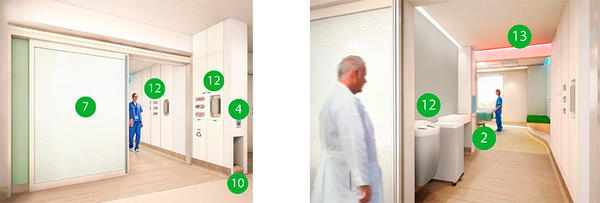Three Strategies for Reducing Healthcare-Associated Infections
According to the Centers for Disease Control and Prevention (CDC), about 1 in 25 hospital patients have a Healthcare-Acquired Infection (HAI) — that is, an infection that develops as a result of medical care — on any given day, and in 2011 an estimated 75,000 patients with HAIs died during hospitalization. Treatment for these infections has led to annual costs of between $28 and $45 billion, and with changing pay-for-performance penalties, their impact on a hospital's bottom line will only increase.
Whether you work in a hospital environment, parallel to it, or only engage with it when you or a loved one falls ill, chances are each of us will be somehow affected by an HAI, which is why our awareness of the issue at hand is critical.
Although tracking the initial cause of an HAI can be difficult, studies have identified the leading causes, starting with human behavior and compliance: the CDC identifies hand-washing as "the single most important method to prevent hospital infections." Hand-washing alone, however, cannot eliminate HAIs completely, because contact with bacteria-laden objects and surfaces can lead to re-contamination, and we've learned from more than one institution that turn-over time for cleaning is a major challenge.
It has became clear that eliminating HAIs requires a "systems" approach, with multiple interventions in the design and function of hospitals and clinics. As architects, we recommend our clients take three approaches to make a difference: reduce the number of high-touch surfaces, eliminate potential host surfaces for pathogens, and increase compliance of medical personnel.
1) Reduce Touch
Approximately 20-40% of HAIs are the result of infection transferred by human touch. Therefore, we suggest reducing the times that staff interact with unnecessary objects before caring for the patient. We turned to the CDC's list of high-touch surfaces to rethink how staff interact with these objects. Some suggestions can be simply implemented, like doorknobs to patient rooms and bathrooms, high-touch surfaces which can become re-contaminated with bacteria as soon as 15 minutes after disinfecting [PDF], but which can be replaced by wave sensors at each location (#4). In the bathroom, both the faucet and hand-dryer should be touch-free as well (#5). And a built-in, closed bedpan washer can eliminate the splash and aerosolization that comes from emptying the bedpan into the toilet and using the washing device (#6)
Other suggestions require more operational changes. For instance, equipment is frequently stored in the patient room even when not needed, which creates additional touchable surfaces even when staff simply move equipment out of the way. By providing a storage alcove outside every patient room, frequently used equipment can be kept in a clean environment until required (see #1 in the accompanying images).
Still other solutions may seem counterintuitive, such as duplicating the overbed table, a high-touch surface often used by both patients and staff; to reduce the potential for cross-contamination, rooms should be equipped with a patient-specific overbed table and a separate staff-specific mobile work surface (#2). As an alternative to workstations on wheels (WOWs), room-specific iPads can prevent the transmission of microbes from patient to patient, and they can be easily disinfected after every use with a UV sanitization locker (#3). They can also control lighting and other electronic devices wirelessly, reducing the need to touch wall switches.
2) Eliminate Pathogens / Hosts
Microbes are everywhere, but reducing the number of host sites can reduce the chance of infection. For instance, window blind cords and chains, along with cubicle curtains, can harbor microbes that can be passed from person to person and are difficult to clean; electrochromic "smart glass" doors and windows instead can provide privacy with the flip of a switch (#7). All surfaces should be non-porous, durable, and easily cleanable.
The room layout also makes a difference. Patient showers create humidity, which, when it encounters a cold exterior wall, creates condensation; once this space is wet, any surface can become a colony of mold, mildew or worse. Inboard toilets reduce this risk (#8). There are many strategies for sealing exterior walls as well: implementing appropriate vapor barriers, insulation, room humidity, and fiberglass-backed wall board instead of paper-backed products (#9).
Finally, if we keep harmful microbes out of the patient environment, we can worry less about how we remove them. an average of 421,000 units of bacteria are tracked in on the outside surface of each shoe, including E. coli, which indicates contact with fecal matter. A simple solution is shoe covers, with dispensers that make them easy to apply and eliminate the potential of contaminating wearers' hands (#10).
3) Increase Compliance
None of these features matter, however, without the cooperation of clinical staff. To make it easier for staff to follow hand hygiene and infection prevention guidelines, the environment should be optimized with strategic, easily accessible locations for such seemingly simple elements as sanitizer dispensers, masks, gloves, shoe covers, sharps containers, garbage receptacles and contaminated supply disposal units (#11). Placed at the room entry, automatic hand washers and dryers can prevent human error and save valuable time (#12).
Where low-tech solutions aren't enough, RFID technology can be used for immediate feedback and compliance reports, though some worry about the "big brother" aspect. RFID technology and color-changing LED lighting can provide a reminder (#13) with warning or indicator lights tied to events: entering the room, washing and sanitizing ones hands, and entering and exiting the patient zone. This signal would also empower patients to remind staff about infection prevention. Low-tech and high-tech strategies alike, however, require the involvement and buy-in of the staff.
Conclusion
HAIs have no simple solution. Product representatives and architects alike must prove that their solutions will do more good than harm, and the quantity of evidence needed to declare something safe is much greater than the evidence needed to declare it poses an unnecessary risk. For instance, a well-known U.S. institution recently banned antimicrobial additives from surfaces in its facilities because the known risk from harmful chemicals outweighed the promised rewards in infection prevention.
With limited scientific proof, and limited existing regulations, it's vital that we continue with this research to better protect healthcare patients. HAIs may never be eliminated completely, but with careful design, we can build much healthier and safer environments.
Kerianne Graham and Sarah Markovitz are leaders in NBBJ's healthcare practice, an architecture firm that designs hospitals and clinics for 11 of the 15 U.S. News & World Report Honor Roll Hospitals, including Massachusetts General Hospital, NYU Langone Medical Center, and Brigham and Women's.



The views, opinions and positions expressed within these guest posts are those of the author alone and do not represent those of Becker's Hospital Review/Becker's Healthcare. The accuracy, completeness and validity of any statements made within this article are not guaranteed. We accept no liability for any errors, omissions or representations. The copyright of this content belongs to the author and any liability with regards to infringement of intellectual property rights remains with them.

